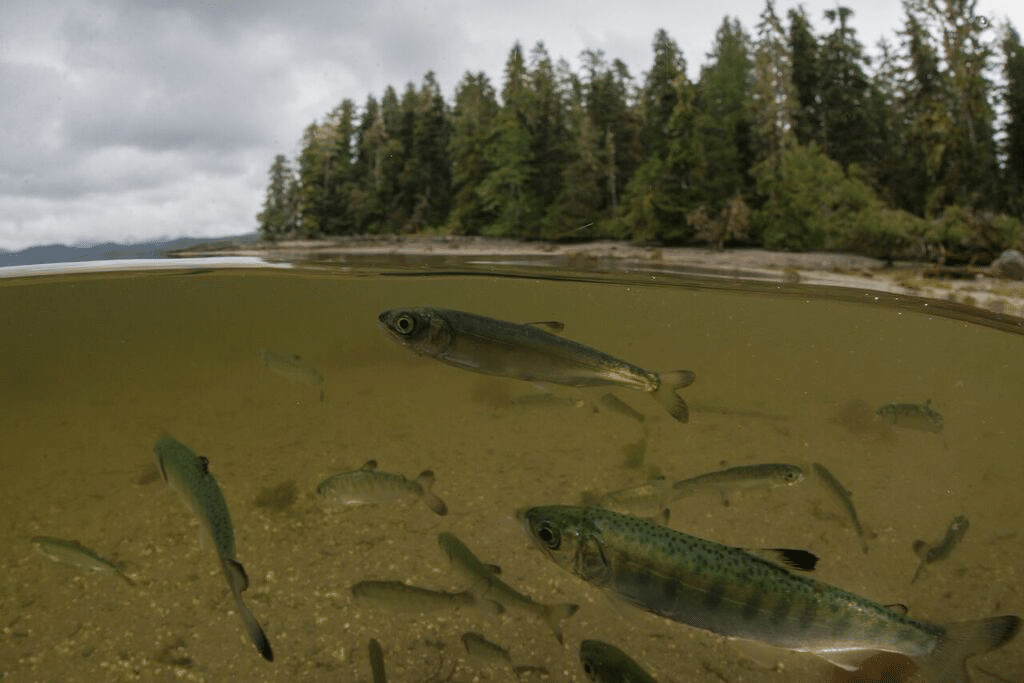In an open letter to Catherine McKenna, Canada’s Minister of Environment and Climate Change, a group of scientists publicly challenged the integrity of an environmental assessment reviewing the impacts of a major liquefied natural gas export terminal on the west coast of British Columbia.
The Pacific Northwest LNG plant, a controversial $11.4-billion export terminal, is proposed for Lelu Island near Prince Rupert. The terminal is slated to be built next to Flora Bank, a unique eelgrass rich intertidal zone scientists have termed a salmon superhighway.
According to salmon ecologist Michael Price with SkeenaWild Conservation Trust, and signatory of the open letter, the environmental assessment of the project represents a “failure of process.”
“There’s certainly a frustration with [the Canadian Environmental Assessment Agency]. We feel CEAA has not incorporated the best available science.”
Price said CEAA asked both Fisheries and Oceans Canada as well as Natural Resources Canada to provide comment on the Pacific Northwest project.
“But what they were asked by CEAA to comment on was a very narrow aspect of the project and had nothing to do with other available science.”
Price pointed out the work of Dr. Patrick McLaren which found the construction of the LNG terminal on Lelu Island would likely cause a mass erosion event at Flora Bank, dismantling the eelgrass beds critical for salmon.
“McLaren has good evidence that by building this structure you’re going to destabilize Flora Bank,” Price said, “but the proponent brings in their own 3-D model saying, ‘well, actually, there will be no negative effects.’”
“Fisheries and Oceans Canada as well as Natural Resources Canada were asked to review only the proponent’s evidence and was not tasked with reviewing any other lines of evidence, even those that are peer reviewed.”
“It’s a failure of the precautionary principle,” Price said, adding it’s also a “failure of process.”
Price said that in a review of CEAA’s mandate it was unclear if a broad spectrum of science had to be considered when performing an environmental assessment.
Like what you’re reading? Sign up for our email newsletter!
“I don’t see any concrete language that CEAA — in the process of assessing risk — that they need to incorporate best available science,” Price said.
“So we could be talking about a process limitation where CEAA 2012 falls short. There could be a loophole where CEAA 2012 isn’t mandated to consider science beyond that provided by the proponent.”
“Is CEAA being negligent? Maybe they’re just following their mandate,” he said.
He added that under current Fisheries Act rules, the proponent is also legally allowed to destroy salmon habitat as long as a mitigation plan is put in place that results in “no net loss of habitat.”
“If you’re going to destroy 27 square metres of salmon habitat you can simply promise to recreate 27 square metres of that lost habitat somewhere else,” he said.
“Very few of these mitigation projects actually equate to the same productivity of natural habitat. Actually creating eelgrass habitat is extremely difficult. We have a hard time as humans to recreate what Mother Nature has created.”
Price added that from a scientific perspective the ecosystem under threat is not easily replaceable.
“What is at stake is at the moment a fairly pristine, highly productive nursery ground for salmon and other fishes.”
“More migrating juvenile salmon have been found here than in any other habitat surveyed throughout the Skeena estuary,” Price said. “It’s a pristine and highly productive natural environment that will be altered significantly. The proponent is quite clear they’re project will have this effect but, they say, they will mitigate.”
And technically, Price said, “they’re following the rules because there will be no ‘net loss’ of habitat.”
He added that the specific mitigation plan to replace the lost habitat hasn’t been made available for the project.
“They can’t tell us what their mitigation plan is because they haven’t developed it yet, but they tell CEAA they are going to recreate the habitat and CEAA says, ‘okay.’”
The public comment period on the draft environmental review ends tonight at midnight.
“Theoretically not only can CEAA consider new lines of evidence put forward but that is what they are supposed to do, incorporate comments or information put forward that is relevant.”
Image: Tavish Campbell
Subscribe to our newsletter
Stay up to date with DeSmog news and alerts






